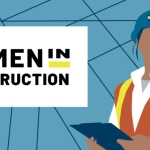Breaking Down the Stigma: Prioritizing Mental Health in Construction
By Conexpoconagg.com | Originally posted on conexpoconagg.com
The conversation around mental health has shifted since 2016 when the Centers for Disease Control reported that the construction industry had the highest suicide rate of any profession. At that time, the Construction Industry Alliance for Suicide Prevention (CIASP) was formed to shatter the stigma surrounding mental health issues. According to Michelle Walker, Vice President of Operations for SSC Underground and CIASP board member, the organization faced resistance at first.
“Some people were saying this isn’t the employers’ job, this isn’t something we should be talking about,” says Walker. Today, she says it’s rare to have naysayers and easier to convince contractors to see the value of investing in mental health.
“Personal success stories are driving the message home,” says Walker. Research from Lyra shows that from 2021–2023, the percentage of workers who said mental health is discussed in at least one way in their workplace nearly doubled—whether through company-wide communications, during team meetings, one-on-one meetings, or peer-to-peer conversations.
Jerry Ouimet, President and CEO of Ames Construction Company, a family-owned civil infrastructure contractor with 5,000+ employees, says their efforts have also shifted since the suicide numbers were first released.
“Our focus evolved from just suicide prevention to mental health and emotional security to a culture of care and treating people like humans, like family,” says Ouimet, who is also a CIASP board member.
Optimize workforce performance
With a shortage of workers, employers are competing for talent and focused on optimizing the performance of the workers they have. “If you’re going to look for a business rationale, your people need to be at their best to win and be successful every day,” says Ouimet. ”You’re just trying to help them be successful.”
The National Safety Council’s (NSC) Mental Health Cost Calculator provides specific information about a company’s cost of mental health (including depression, anxiety, and general mental stress) based on the number of employees, industry, and state. This includes costs for lost time, job turnover and training, and excess health care. The NSC reports that organizations see a $4 return in improved health and productivity for every $1 invested in mental health treatment,
Recent research shows an increasing number of companies offering mental health benefits. In a 2022 Employee Wellness Industry Trends Report, from Wellable Labs, 90% of employers reported increasing their investment in mental health programs, 76% reported increasing investment in stress management and resilience programs, and 71% were increasing investment in mindfulness and mediation programs.
Between lagging data for suicides and the pandemic, measuring the impact of suicide prevention efforts is challenging for companies. But the lack of hard data hasn’t kept companies from moving forward.
“I get calls all the time from our folks that they’re grateful that we’re talking about mental health,” says Ouimet. “They’ve been able to implement some of the tools and made a difference in someone’s life. That’s pretty powerful.”
“Unlike other safety trainings, this is something that can impact employees positively in all areas of their life,” says Walker. “It could be a child, a spouse, a friend, or a sibling who benefits.”
Construction industry mental health resources on the rise
According to Walker, the CIASP will be hiring its first executive director in 2023, and developing a roadmap and a toolkit of suicide prevention and mental health best practices for contractors. It costs nothing to take the pledge to stand up to suicide or to access any of the organization’s resources.
In addition, several construction industry associations are also focusing their attention on mental health. In January 2023, The Associated Builders & Contractors National Health and Safety Committee, with input from experts in mental health, addiction, and suicide, announced it had completed the development of a Total Human Health component to its safety program. It encompasses actions, initiatives, and policies that emphasize the health, well-being, and livelihoods of workers by incorporating a whole-person approach to engage workers.
The fact that mental health has an impact on safety on the jobsite is something that resonates with contractors. “If we want a productive, safe workforce, we need to equip people to be in the best mental space possible to be able to do that,” says Walker.
Associated General Contractors of America (AGC), which has supported suicide prevention and mental health programs over the years, formally established a Mental Health & Suicide Prevention Task Force in January 2022. According to Mandi Kime, who serves as Co-Chair of the task force and Director of Safety for AGC of Washington, the first goal of the task force is to create a free open-source clearing house for all of the content that’s available for mental health, suicide prevention, substance misuse and addiction, specifically for the construction industry. A series of powerful videos tell the stories of industry professionals who have struggled with mental health, in the hopes of letting others know they are not alone.
“We need people being boldly vulnerable, people that we look to as leaders in the industry saying, ‘Hey, I struggled, but I got better. And here’s how I got better,’” says Kime.
“I have seen an overwhelming amount of people reaching out to AGC of America; asking for speakers to come to company functions or resources for them to do it themselves, says Kime. “People are really ready to have the conversation,” says Kime.
“I think we have under underestimated people’s willingness to have the difficult conversation,” says Kime. “They just want tools and resources to do it appropriately. They want to do it right; they just don’t quite know how.”
In part 2 of this series, our Step-by-Step Guide to Improving Mental Health and Wellness in Construction will connect you to many of these resources.
The business case for investing in mental health
- 5 days of work every 3 months are lost by employees who are experiencing depression
- 19% loss in productivity due to depression1
- 50% of U.S. workers have left a previous job, at least in part due to mental health conditions2
- 62% of missed days are attributed to burnout, depression or anxiety3
- $4 return in improved health and productivity for every dollar invested in mental health treatment4



